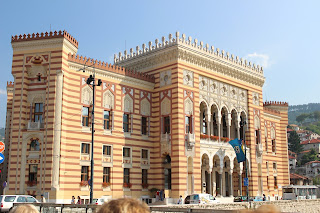On Thursday, August 25th, we met a local guide, who walked us from our hotel three blocks east, past the ruins of the 16th-century han or caravanserai, past the 16th-century bezistan or covered bazaar (still in operation), then around the corner and down a block, past a plaque on the building to our left, as we wait for the light to cross a busy street, to the old bridge on the other side. We go over the bridge, over the river, to the quiet of a large park, then turn back to look at the corner with the plaque. There, said our guide, was where World War I began.
Unlike some other towns in the Balkans, Sarajevo is a relatively new city, founded by the Turks in 1461, not long after they conquered Bosnia. From the beginning it was the administrative capital of the region—its name means “plains of the palace” or “palace place.” Bosnia is, as a local man pointed out to us the next day at lunch, at the northwesternmost frontier of the Islamic world. The people of Sarajevo, mostly Muslim, are the descendants of local Christians who converted to Islam under Turkish rule. They are otherwise indistinguishable from the region’s Orthodox Serbs and Roman Catholic Croats, and they all speak the same language, though each group denies that fact, pointing to minor differences in dialect to support the idea that there is no such language as the “Serbo-Croat” of my 1990 Berlitz phrasebook.
I want to talk a lot more about Sarajevo, but first I have to take us through the rest of this day.
Our guide took us up the river to point out the City Hall built by the Austrians (in a bizarre pseudo-Moorish style), then went through the old Turkish town, visiting the chief mosque and, finally, the late-nineteenth-century Austro-Hungarian city. In front of the Cathedral, our guide pointed out a Sarajevo Rose, a place where shell fragments from the 1992-1996 siege have scarred the pavement. As Wikipedia says:
"Throughout the city, explosion marks have been filled with red resin to mark where mortar explosions resulted in one or more deaths.
“The Sarajevo roses are disappearing as the asphalt is replaced.’
This is not an ordinary place.
But life now goes on, so we stopped for a snack, which was so filling that it turned into lunch. We went into a fast-food place specializing in burek, a meat pie, and its vegetable-filled cousins.
Since we had the afternoon on our own, we first went back to our room, where I contemplated (and photographed) the various currencies we would use on this trip: kuna in Croatia, euros in France, Montenegro and Slovenia, Bosnian marks. I forgot to get out my British 20-pound note.
Mary Joy and I visited the City Hall, gutted by Serb shells on the night of August 25-26, 1993 (exactly 23 years earlier), but completely rebuilt following the original plans. Then we went to the old synagogue, which is now a museum relating to Jewish life in Sarajevo before and during World War II
On the way to dinner, Ivana took us to the Coppersmiths’ Street, which is now occupied by the shops of—guess: coppersmiths!
Then we stopped in at a shop where the proprietor made “boza,” a refreshing drink from corn.
Dinner was at a restaurant specializing in Bosnian dishes and was served “family style.” Very good.


































No comments:
Post a Comment